Huawei P10 and P10 Plus: Performance & Battery Life Report
by Matt Humrick on May 12, 2017 7:00 AM ESTCPU & System Performance
The P10 and P10 Plus both use the same Kirin 960 SoC from HiSilicon as Huawei’s other flagship phone, the Mate 9. We already looked at Kirin 960’s performance and power efficiency in detail, and we also reviewed the Mate 9 earlier this year, so the two P10’s we’re testing now should not provide many surprises. The only outstanding questions are what type of RAM and NAND our units have, and do the P10s still perform the same as the larger Mate 9?
To evaluate overall system performance, we turn to the PCMark Work 2.0 suite, which tests the combined effects of the CPU, GPU, RAM, and NAND storage. Because it uses standard Android API calls and runs several different real-world workloads that elicit realistic behavior from the CPU governor (unlike synthetic tests that simply run one or more CPUs at max frequency), it’s a good indicator of everyday performance.
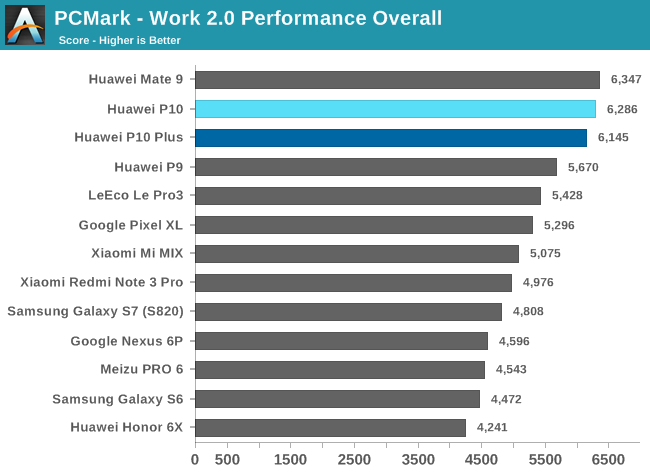
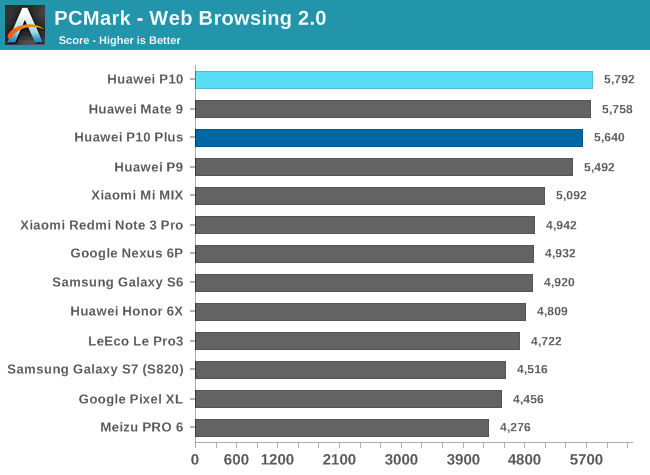
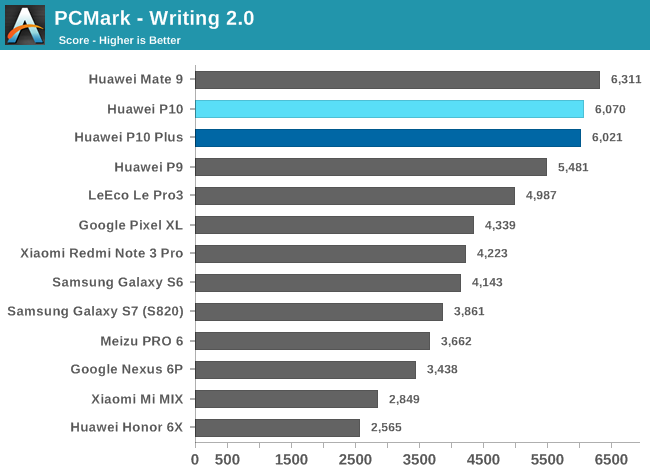
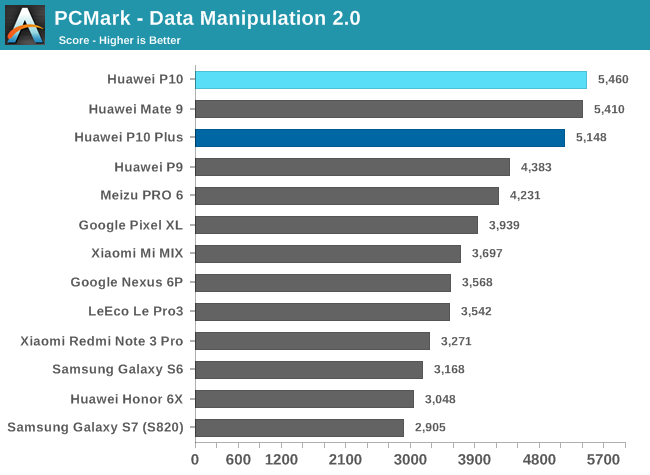
As expected, there’s no significant performance difference between the P10, P10 Plus, and Mate 9 in any of the PCMark Work 2.0 tests. All three phones post excellent results, with the P10 outperforming the older P9 and its Kirin 955 SoC by 11% overall.
There is not much difference between Huawei’s current generation flagships and last year’s P9 and Mate 8 in the Web Browsing test. The P10 Plus holds a slim 11% lead over Xiaomi’s Mi MIX and its Snapdragon 821 SoC, which grows to a more significant 27% lead over the Galaxy S7 and Pixel XL.
The Writing test is characterized by frequent but short bursts of activity that benefit from running on the big CPU cluster. While CPU IPC and frequency are important here, so is the phone’s proclivity to migrate threads onto the big cores. Huawei’s phones perform well once again in this test, with the P10 maintaining its roughly 11% advantage over the P9. There’s significantly more variation among the other phones in the chart, with the Mi MIX landing near the bottom at only half the performance of the P10. The Pixel XL trades places with the MIX in this test, but is still outperformed by the P10 by about 40%.
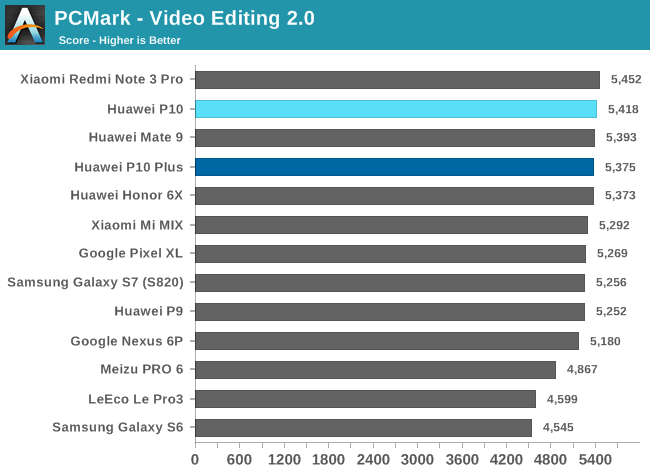
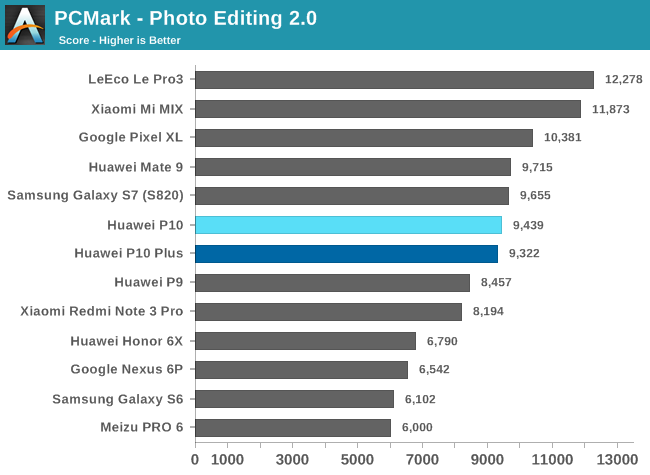
The PCMark Video Editing test is not particularly strenuous, so most phones perform about the same. The Photo Editing test, which uses both the CPU and GPU for applying various photo effects, produces more interesting results. It’s the only PCMark test where Huawei’s phones do not finish on top. Instead, phones using Snapdragon 820/821 SoCs and Qualcomm’s Adreno 530 GPU perform the best when running these workloads. The P10 holds a slim 12% advantage over the P9, but the Snapdragon 821 powered Le Pro3 is 30% faster.
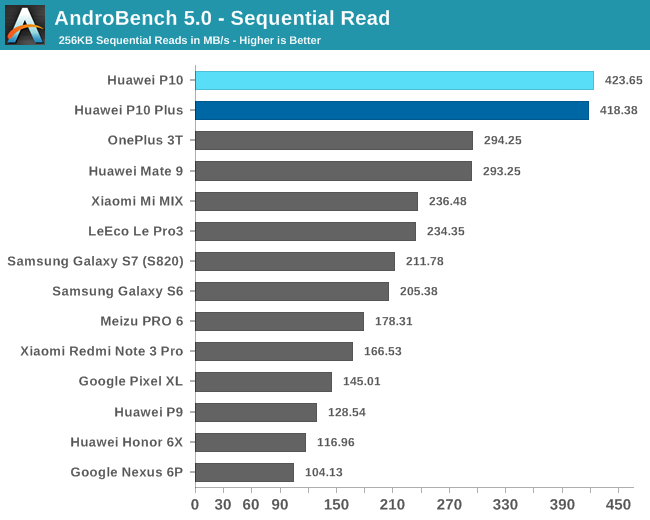
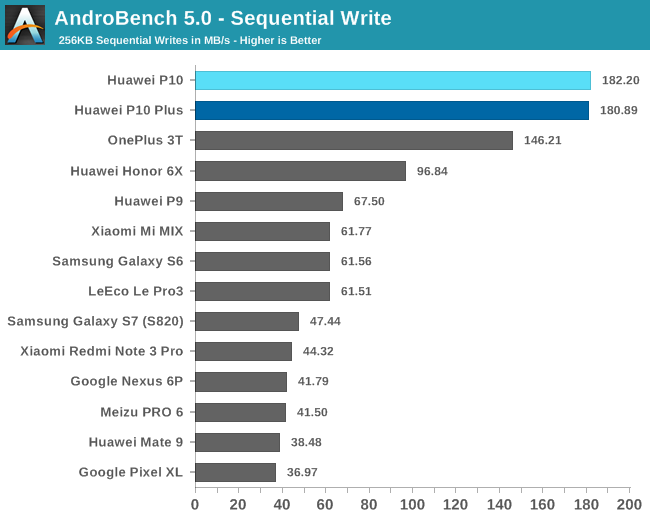
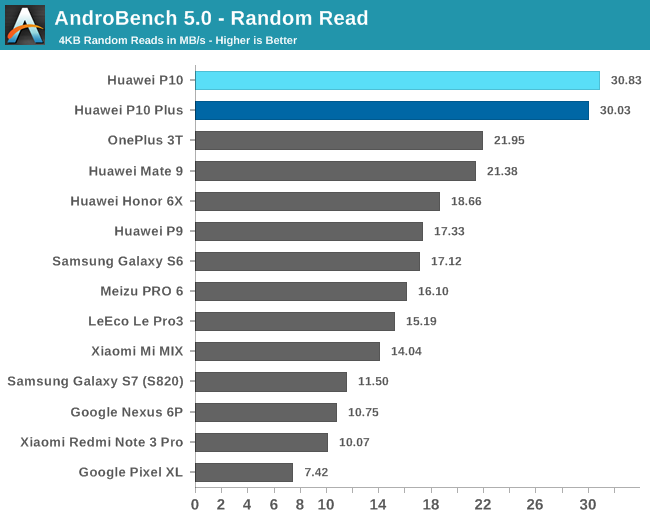
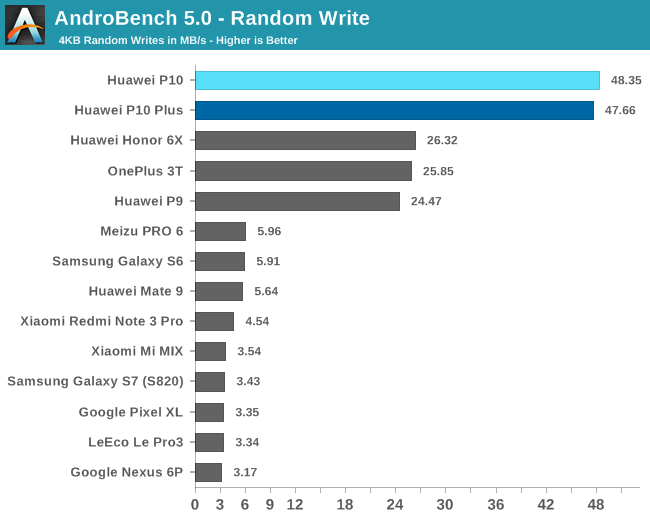
Obviously there is nothing wrong with storage performance for our P10s. Both the P10 and P10 Plus post excellent (and essentially identical) sequential and random throughput values. It’s also worth noting that both units are using UFS 2.0 NAND from Samsung.
The P10s easily outperform the Mate 9, especially when writing data sequentially or randomly. This particular Mate 9 is using UFS 2.0 NAND from Toshiba, which illustrates an important point: Just because a phone uses UFS 2.0 or 2.1 NAND does not mean it will perform well. Storage performance is multi-layered, starting with the operating system kernel and eventually ending at the storage controller and NAND itself. Even the underlying filesystem makes a big difference, with the P10, P10 Plus, P9, Mate 9, and OnePlus 3T all using the better performing F2FS (Flash-Friendly File System) for the /data partition instead of the default EXT4 file system.
With all of these variables in play, it’s impossible to even say that UFS NAND is always faster than eMMC NAND. For example, the Huawei P9, which uses eMMC 5.1 NAND, outperforms the newer Pixel XL and its UFS NAND in all but the sequential read test. The P9 also outperforms the Mate 9 in both writing tests. Now this does not mean a P10 with eMMC 5.1 NAND would perform the same or better than the two UFS examples we tested (it would not be able to match the sequential numbers at least), but it is important to take a step back and see the bigger picture.
| Storage Performance (AndroBench 5.0) | ||||||||
| Seq. Read (KB) |
Seq. Write (KB) |
Random Read (KB) |
Random Write (KB) |
|||||
| 1024 | 2048 | 1024 | 2048 | 8 | 16 | 8 | 16 | |
| Huawei P10 | 499.35 | 541.97 | 185.50 | 185.18 | 55.73 | 96.00 | 84.86 | 139.32 |
| Huawei P10 Plus | 516.78 | 558.45 | 182.24 | 183.15 | 53.22 | 93.37 | 82.52 | 137.51 |
| Huawei Mate 9 | 429.17 | 480.07 | 74.60 | 100.01 | 38.81 | 66.27 | 10.77 | 16.99 |
| Huawei Honor 8 | 169.07 | 198.77 | 83.65 | 102.45 | 30.2 | 46.25 | 17.17 | 26.59 |
The table above shows how storage performance scales with larger IO sizes. While the values we use in our general tests above represent the most common IO sizes, other workloads, notably accessing media files like photos and video, will utilize larger IO transfers, so it’s important to see how a phone performs over a wider range of scenarios. Sequential read throughput for the P10s continues to scale as expected, maintaining their lead over the Mate 9. Sequential write performance does not scale any further and only maintains its already high values. The Honor 8, which uses eMMC 5.1 NAND like the P9, manages to outperform the Mate 9 when writing sequentially or randomly at any IO size.
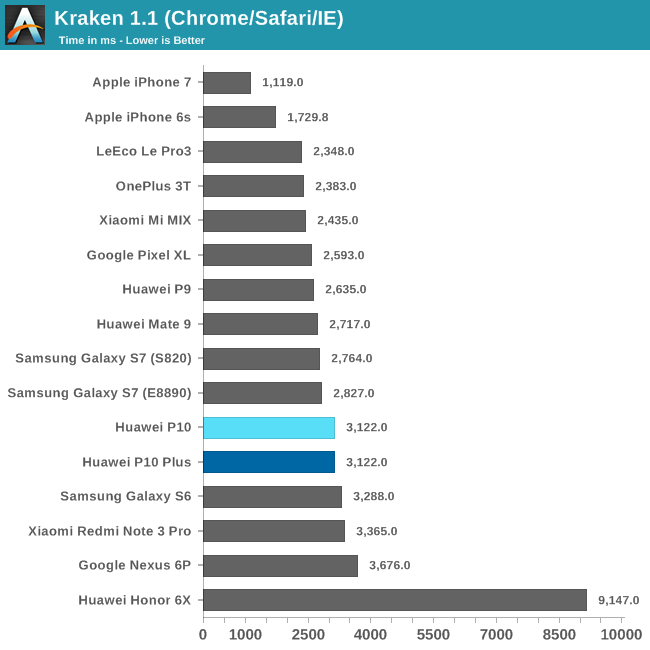
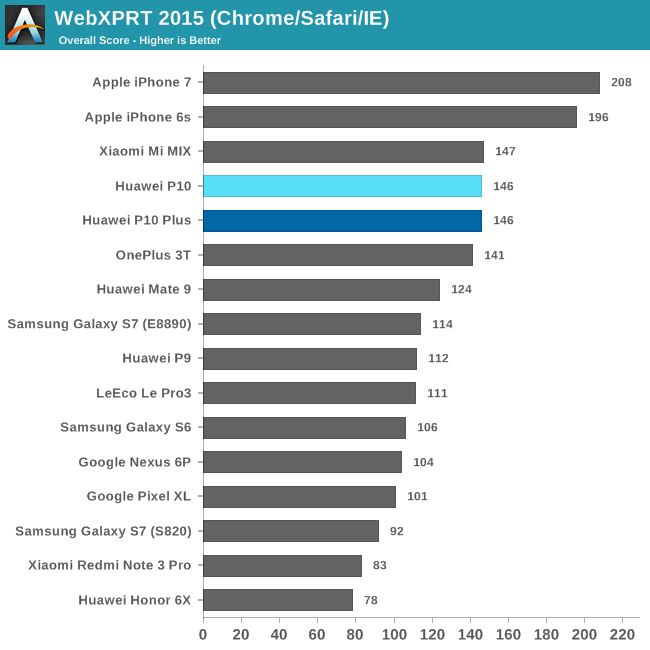
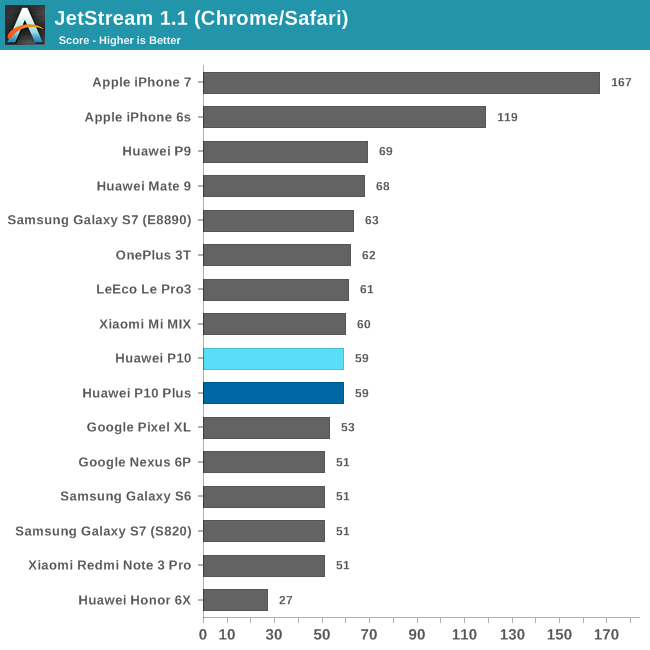
In the Kraken JavaScript test, both P10s fall behind the Mate 9 by 15%. The P10’s A73 CPU cores also cannot match the performance of the higher frequency A72s in the P9’s Kirin 955 SoC, or the custom Kryo cores in the Snapdragon 820/821 devices. The P10s do outperform the less-expensive Honor 6X by a factor of three, highlighting the performance deficit of using octa-core A53 CPU configurations instead of pairing the A53 cluster with 2-4 big out-of-order CPU cores.
Finishing positions flip in WebXPRT 2015, with the P10s out in front of the Mate 9 by 18% and the P9 by 30%. Scores in JetStream show less variation, but the P10s fall behind the Mate 9 and P9 once again by 17%.
The tests above corroborate my own subjective experience with the P10: It’s fast. Common tasks such as installing or opening apps, switching between running apps, and searching through my email inbox complete quickly. The redesigned EMUI 5.1 UI is smooth and responsive—not Pixel XL smooth, but flagship smooth.










74 Comments
View All Comments
John Other - Sunday, May 14, 2017 - link
I've not used the Pixel, but can confirm that my P10 is really very smooth and responsive and a pleasure in general use.But I can absolutely imagine that with the OS familiarity Google has, on the same hardware, battery smoothness is entirely possible. Gratuitous car analogy: Mercedes-Benz not quite a Bentley.
On the other side of the coin, I think the physical build, first rate certainly, you will be able to sense as short of a iPhone 7, if you ever once use the iPhone for a while. The iPhone has the better mass distribution of the two, the P10 just a touch weighted on the left. It may be my recovering hand from injury that makes my hold less secure than before, but I went to a store specifically to jog my recollection. IPhone definitely wins in the purely illusory feeling of security in holding balance. I caveat this with the fact that during recovery from my hand in which my index finger was badly broken, I perceived that perfectly flat items like credit cards I gripped were concave. So my touch is not calibrated. However the impression I relate is that which I went to check only last week.
I should further note that my P10 replaced my LUMIA 650. This was too close a call entirely due to the LUMIA 950 XL making the only sensible decision that just does not feel sensible any longer. Other than the state of hardware, and sorely needed Edge advancements, the switch from Windows 10 Creator's Mobile, is one I simply would not have called, was a Microsoft direction visible. I think it is testimony to Steve Ballmer, how much survived, superannuated, that remains very good. Nadella appears to have had to asphyxiate the Ball er legacy plans, as if he couldn't present good reason to shut them down. Microsoft have forgotten that cutting off the air supply is supposed to be done to the competition.... But if Windows Phone is the price of maturing beyond that level of aggression, in a market where we need software integration absent hardware leaps, to drive performance, then so be it. Just to not tell the world, of such a positive game plan, beats me.
Speedfriend - Friday, May 12, 2017 - link
The thought that you can buy a product that may be totally different to the review that you have read is crazy. They should be punished by no one buying themphilehidiot - Friday, May 12, 2017 - link
Indeed - I find it very disturbing that the phones could be either a modern spec (and I have to assume Anandtech were supplied with the best possible article) or falling behind even last generation in some areas. There's a difference between SoCs which are binned and fall within a bell curve and totally different components. Yes, the difference now might be marginal in terms of experience but as software becomes more hardware intensive you expect that perceptive performance to be maintained for a reasonable timeframe - this is one reason why you're paying double for a flagship phone.I'm sorry but if someone offered me a PC and it could come with either a HDD or SSD or DDR3 or DDR4 depending on luck and oh, by the way the cost is the same regardless of what you get and we won't tell you, you'll just have to find out when you get it.... I'd tell them to fuck off. It's an absolute disgrace and sticking two fingers up at your customer. I understand there are shortages and intense competition but if you're going to do this then you DROP YOUR PRICES! You can't charge the same as a modern flagship with the risk of getting components 1-2 years out of date (relative to flagship specification).
In addition to this, you have to consider optimisation may well suffer. You've got a closed system with components all working on one system (UFS) for example and you can spend time optimising everything to work with that. Suddenly, due to suppliers, you have to optimise late in the design phase (probably when mass production techniques have already been devised and they're now looking at supply - I assume, I'm not in the industry, let me know if I'm wrong) for not just UFS but eMMC as well which adds complexity and potentially adds bugs. As WELL as slowing down updates as they end up more complex.
If you're going to violate your customers like this then you have to offer them something in return, ideally reduced cost. They are competing with standardised flagships on price and, whilst I was very interested, knowing I could be getting something markedly different to what I'm paying for makes this brand a no, no for me.
"Yes, sir, you ordered the caviar"
"Well, I appear to have a pear with a turd next to it"
"Sorry, Sir this is how our restaurant operates. We can't always get supply in to meet demand so we carry on charging the same but give you what you'd get in a dirty cafe."
"Well, I'm sorry, I'm returning this and I want a refund"
"Sorry, Sir... it did not say anywhere that you wouldn't get a pear instead and you ARE being provided with something that came out of an animal, so you have no grounds for complaint"
"Oh you can just fu......"
John Other - Sunday, May 14, 2017 - link
The P10 is by far the most modestly priced of the flagships.UK retail carrier unlocked, I think dropped below pounds 600 last week.
I find that I am soundly impressed with the understatement of this phone. Everything about it infuses me with confidence. Only a removable battery, would be my request. (for which surely there must be a elegant engineering solution (plastic backs are decades behind the build quality we expect from any other than budget categories, and the semi liquid packed character must be solvable, alongside a truly solid attachment mechanism, clip on flush not insert and cover)
I can't compare but watching the Formula One qualifying sessions yesterday, on Now TV over LTE, the sound was of a quality comfortably filling my small hotel room, all 4 by 5 yards of it, and I could make out the transmission artefacts hampered car to pit radio, and even the transmission of the cars in corners, on the internal speaker. If this is the general quality to expect nowadays, we're doing well, I don't see the need to be gloomy about the market demand for upgrades etc.
fanofanand - Friday, May 12, 2017 - link
Very generous of you to assume that the gimped phones will still be fine and dandy for the end consumer. You seem to be forgiving of the practice, or at least understanding. I am not. If you can't procure the parts you don't sell the product. This kind of bait and switch is precisely the kind of thing people will point to when they say they will "never buy a chinese phone"Matt Humrick - Friday, May 12, 2017 - link
It's not that I condone the practice, I just want people to understand that this happens frequently and why it happens. I've seen LG use display panels of significantly different quality in its G-series phones, and Samsung use different camera sensors (with equivalent specs) on its Galaxy phones that produce images that look completely different, for example. So the P10 is not even the worst example of multi-sourcing. Huawei needs to be more truthful in its advertising, though.invinciblegod - Friday, May 12, 2017 - link
Apple did something similar where the SOC was manufactured by Samsung or TSMC. Apparently, the TSMC one was slightly better but only marginally.levizx - Friday, May 12, 2017 - link
No, not even remotely close. A9 was merely manufactured by different foundries, they have identical design and spec and are pin-to-pin compatible. Difference is only the average power consumption, but even chips cut from the same wafer have different power consumption.eMMC/UFS2.x OTOH are incompatible standards, they don't resemble each other in any way.
levizx - Friday, May 12, 2017 - link
Problem is QUALITY aside, different suppliers still have nominally similar specs, ie all IPS LCD, same sensor size & pixel count.Now, I can understand mixing UFS 2.0/2.1 since they have similar specs and can nominally perform similarly.
eMMC 5.1 is a totally different standard/interface. I'll be replacing AMOLED with TN LCD.
drajitshnew - Saturday, May 13, 2017 - link
Matt I was very interested when I started the review, but lost most of my interest when the variability was revealed. Then on I just skimmed through the review.What is the point of the review if the system YOU purchase could have memory a generation behind, storage 2 generations behind, and a different bin of processor? There was a quite a ruckus when apple dual sourced CPUs with marginally different preformed.
At the very least either you or your should add caveat emptor or YMMV, in BIG BOLD letters to the end of the review. The reputation of anandtech.com deserves at least that.